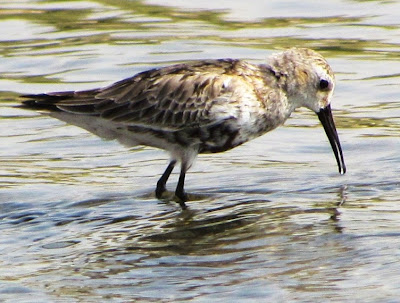The original plan this weekend was to go to Damman on the east coast but it had to be abandoned at the last minute. So at short notice I chose to have a second look locally at Wadi Hanifah.
I knew this would be a safe option as I didn't have enough time to view it properly last time as the temperatures soared and made me leave early.
This time I decided I should take a closer look at the passerines which are mostly smaller birds.
Since last week I have researched more on the birds of the area and as a result I need to correct what I said last time about Riyadh being at the edge of the Western Palearctic area. In fact, strictly speaking its just beyond the edge and is near the north eastern edge of the Afro-tropical region. Its also very close to the Indo-Malay region too. Its a sort of east meets west meets south for birds. This explains why many of my new finds are in the accidentals, vagrants and introductions sections at the very back of my trusted Collins Bird Guide which covers the Western Palearctic.
I have tracked down one copy of Helms "Birds of the Middle East" to one store in Riyadh which is holding it for me. Lets see whether I can get my hands on it tonight.Meanwhile, I am going to blog about today's sightings at Wadi Hanifah and for the most part I won't report on the same birds I saw last week .
The first of the new ones is Namaqua Dove. It is surprising I missed it last week because it was fairly common this week. I saw a nice group of three juveniles first and then several adults including the pair below. Collins guide describes them as shy but that wasn't my observation. I have only seen one once before and that was fleetingly in Senegal. |
| male and female Namaqua dove |
It was 8 degrees cooler this Thursday compared with last which gave me more chance to see the smaller birds however it had still reached 31C when I left and the bird activity had dropped off. The cooler temperatures allowed me to appreciate this remarkable setting.
part of wadi Hanifah south of Riyadh
All the egrets and herons were there again and were more active in the more amenable temperatures but I won't detail them as I didn't spend any time following them this week.
grey heron flying overhead
Getting back to the smaller birds, I was pleased to pick out a small number of blue cheeked-bee-eater among the bee-eaters. Last week I only identified little green bee-eater. The latter is definitely a known local breeding bird. It will take me a couple of seasons of watching to determine the status of the blue-cheeked bee-eater. Who knows some of them may breed locally too though passage and wintering may be more likely.
first year blue-cheeked bee-eater today at Wadi Hanifah
Incidentally its nearly three years since I last saw one (in Azerbaijan) where they are quite common in summer.
little green bee-eater seen today
There is no mistaking it for the little green bee-eater.
common myna
Another passerine I didn't see last week is common myna. I came upon a large but loose flock quite early on. This bird is spreading from eastward from its Indo-Malay base all through the Middle East. In many places its believed they are local populations are the result of escaped birds but Riyadh is close enough to their naturally expanded range for this to be debatable.
house sparrow
Talking of Indo-Maaly birds, I have read from authoritative sources that Indian silverbill is now found in some parts of Saudi Arabia. I made a specially effort to find it. I assumed it behaved similarly to the African silverbill I had seen in Senegal. However for most of the morning I was rewarded in my search in likely spots with flocks of house sparrow!
Indian silverbill
However, my patience paid off, I didn't see a flock but I did sight two in the reeds of one of the larger lakes. This turned out to be my only "Lifer" today.
Isabelline wheatear
More than half a dozen types of wheatear have seen in the area. however I raised my total to two following a couple of separate sightings of isabelline wheatear. Their sand coloured plumage makes them very difficult to pick out.
willow warbler
I felt more at home (and indeed more like birding in Libya) when I came across a willow warbler in some scrub. I wonder if they winter here or whether the bird was still on passage. In Libya willow warbler don't winter (though chiffchaff do in their thousands), but Riyadh is warmer and further south.
I tried hard to find other passerines. Each time I heard "reed warblers" they moved off before I could ID them and I chased what was probably a scrub warbler around in two separate places. I can't claim them however. There has always got to be a challenge for next time.
Before I move on from the smaller birds, I must report I saw several green sandpiper near the water's edge and one hoopoe in the most southerly area I visited today.
booted eagle
Though I was looking out for smaller birds I didn't pass up the opportunity to inspect two booted eagle which passed over-head. Along with a kestrel also seen today, my list of birds of prey here is slowly getting longer.


















































